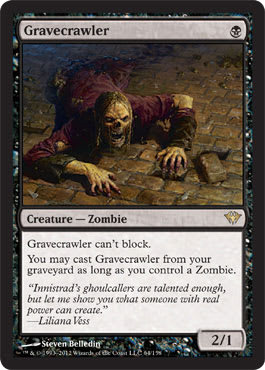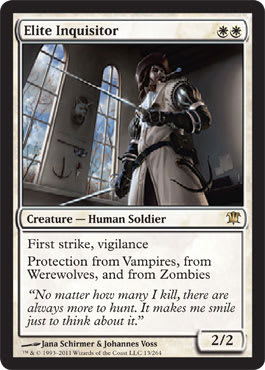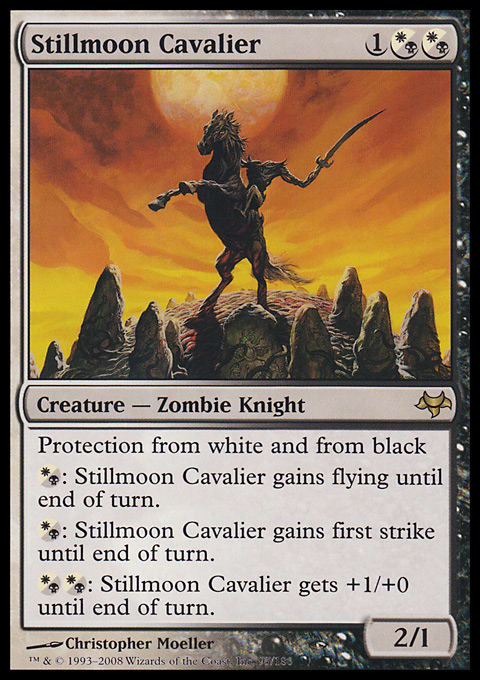Today, I’m back to talk about Zombie Cube and how it’s evolved over the past two months. But seeing as Gen Con was last week, I’d be remiss to not start there. First of all, if you’re a gamer and have never been to Gen Con, pause reading this article and start planning your trip for 2014. This year was a blast as usual, and things started off right on Wednesday, before the convention had even officially started.
The GatheringMagic party was held at a bar in downtown Indy where I drew and handed out promo GM tokens for most of the night. Around midnight, I was exhausted, but not enough to give up on a late-night Zombie Cube Draft. Luckily, there was no shortage of excellent magicians eager to play, including such luminaries as Sam Black and Caleb Durward. I’ll say this: It’s always nice to have both fresh and extremely competent eyes on a new Cube, as feedback from those players is invaluable to making the Cube a better experience. Those aforementioned two ended up on the side of good for our six-man (yes, there was much bemoaning that Sam was not an auto-Zombie). About two hours later, the teams were tied up, but I called the Draft early in order to grab a few hours of sleep before the con opened in the morning.
The rest of Gen Con was unsurprisingly incredible. I fired off two more Zombie Cube Drafts over the weekend in addition to drafting Common/Uncommon Cube, Combo Cube, 1994 Cube, and a custom videogame-inspired Cube. I ate well, talked with fans, hung out with friends, learned new games, True Dungeon’d, and the list goes on. Seriously, if you’ve never been, remedy that wrong as soon as possible.
So . . . Zombie Cube. What’s changed?
The answer is a lot. Since posting the initial list back toward the end of June, I’ve made one hundred fourteen individual card changes. We’re talking nearly a third of the Cube that’s turned over in just two months. Many experienced Cube designers will tell you to not change too much of a new Cube at one time. A lot about accurately evaluating cards is based on understanding the environment they operate in, and mixing too much up can really turn things on their heads. That’s typically excellent advice, and I encourage beginning Cube builders to follow it. However, having a lot of experience fine-tuning my Common/Uncommon Cube, I feel I’ve developed a strong ability to gather information quicker, really engage my drafters, and immediately get a feel for what’s working and what isn’t. Most of these changes can be broken down into groups that either address a specific problem or push a successful theme.
1. Your Drafters Will Always Draft with Power in Mind.
This seems so obvious, but I have to remind myself of it sometimes. It’s something that any Cube owner should consider. One of the early issues with the Zombie Cube were the “cute” cards that were awesomely flavorful but didn’t have a home in any good Draft deck. Dawn of the Dead is a great example. It has an amazing name and great flavor, but no one ever played it because it didn’t contribute to any winning strategy. Don’t get me wrong, this Cube is still all about flavor, but the unplayable cards had to go, regardless of how much “sense” they made in the Cube.
2. Protection Is Not Unbeatable, Uninteractive, or Unfun.
Initially, I was extremely apprehensive about including protection creatures in the Cube because I felt they were too big of a hurdle for opposing decks to beat. I felt so strongly I wrote in my previous article, “While the average Zombie deck probably has plenty of answers to a card such as [Elite] Inquisitor, the game becomes extremely unfun and uninteractive if the Zombie player doesn’t have an answer (or hasn’t drawn one).” What I discovered after a few Drafts is that both sides really yearned for these powerful trump cards, and the challenge of beating one was actually quite fun for gameplay. As a bonus, cards like Elite Inquisitor and Fiendslayer Paladin are not only extremely flavorful, but also easier to defeat than, say, White Knight. I remain cautious about how many protection creatures each side has access to, but I was wrong in neglecting to include them in the first place.
3. Nonwhite, Nonblack Multicolored Cards Are Unplayable.
After the first handful of Drafts, it was apparent that Human players would always be playing White/X decks, and conversely, Zombie players would be playing Black/X. That, again, seems very obvious now, but it meant that the few nonblack, nonwhite multicolored cards I included in the Cube would never be played. Out they went.
4. W/B Is Near-Unplayable for Either Side.
Related to the multicolored changes, I quickly noticed after four or five Drafts that no one was ever W/B despite the archetype having a reasonable amount of support. After all, Zombie players could play cards such as Necromancer's Covenant and white removal, and I assumed Human players would love to dip in to black’s Terrors and maybe a Death Grasp. Several Drafts later, it still hadn’t happened. Because neither side can play the opposite color’s creatures, drafting W/B just isn’t intuitive, and the multicolored cards aren’t a strong enough incentive to pull any player into the color combo. After Gen Con, I decided to cut most of W/B’s multicolored, save Stillmoon Cavelier, which is essentially a black card, and Necromancer's Covenant, which is still very splashable. Godless Shrine and Tainted Field also remain, as I feel two cards is a low enough opportunity cost to help a drafter who wants to splash.
5. My Numbers Were Slightly Off.
The numbers of the initial build within this Zombie Cube were largely based on what the Cube looked like when I built it pre-Innistrad. White had sixty cards, black had one hundred twenty, and the remaining colors had thirty each. The idea here is that some sort of bizarre balance is achieved because more of the nonblack creatures are Humans, and Zombie decks lean more heavily on black rather than being an even two-colored split. I think I was fairly close with those first numbers, but with the realization that W/B wasn’t going to happen, I decided to do a little counting. I added the total number of white cards to the total number of nonwhite Humans and compared that number with the total number of black cards added to nonblack Zombies. There was around a thirty-some card difference in favor of Zombies. This meant that Zombie players simply had access to more creatures. The imbalance wasn’t incredibly apparent when drafting, but I decided black should be trimmed a bit, and I ended up adding fifteen cards to the white section. Accounting for cards such as Strength of Night or Grave Bramble that only serve one side and the card pool, the difference now stands at only twelve—a much more acceptable number.
6. Utility Lands Are Fun!
This is a less-format-defining insight, but I’ve been very happy with the way the nonbasics have worked out in Zombie Cube, specifically the utility lands. I started with Unholy Grotto, Keldon Necropolis, and Daru Encampment. I’ve since added Mutavault, Lake of the Dead, Kjeldoran Outpost, Wasteland, and Strip Mine. Lands have always been a big part of cubing, and incorporating more into the Zombie Cube has only richened the environment. I’ve seen every single one of these lands do something awesome in at least one deck (you haven’t lived until you’ve had the Necropolis–Gravecrawler engine), and Strip Mine and Wasteland are good safety valves to make sure nothing gets out of hand. Obviously, those two are good tempo plays in their own right.
And that’s it! The Cube feels like it’s in a really good place now, where I can back off on huge swaths of changes and do more fine-tuning with each new Draft. I’ve said in the past that working on C cube is half the fun of owning one, and owning a new Cube just brings more discovery to the mix. Over the Gen Con weekend, I added a Zombie/Human win tally to the inside of my long box, and I look forward to seeing if one side will pull ahead over the ongoing apocalypse. I’ll be sure to keep all you warm bodies and undead updated—stay tuned.
- Eric
Email: eaklug at gmail dot com
Twitter: @klug_alters

































